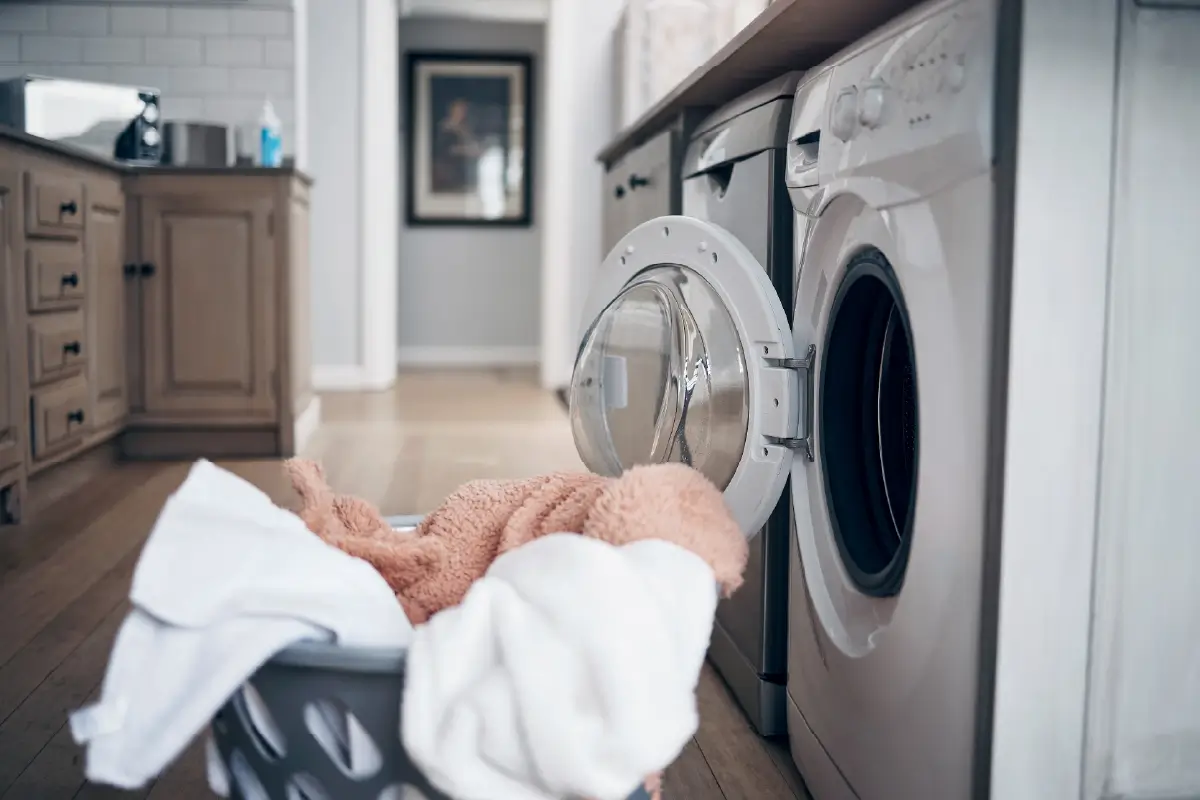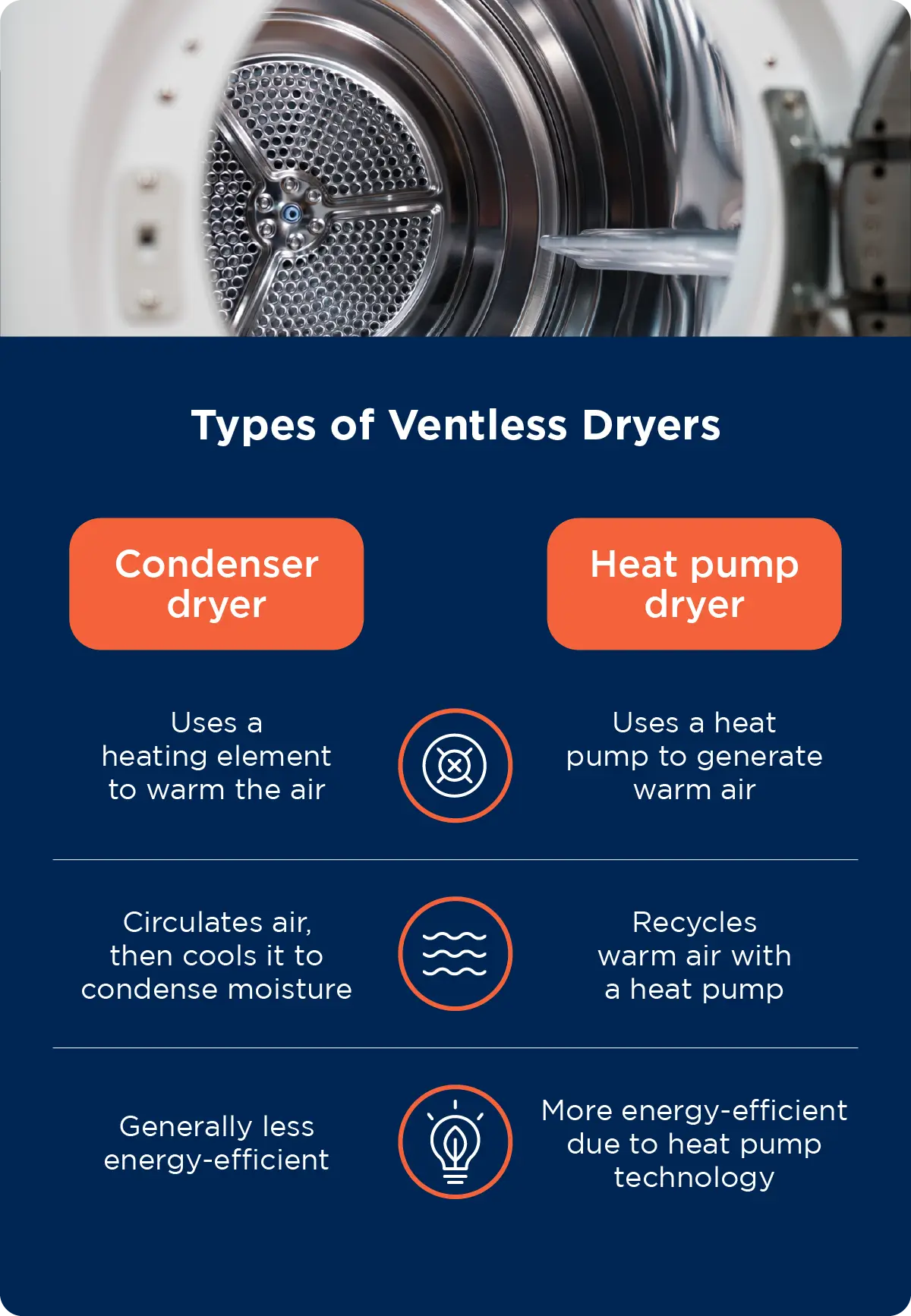Ventless Dryers Pros and Cons

|
A ventless dryer dries clothes by circulating heated air within the drum, eliminating the need for an external vent. |
Nearly 80% of U.S. homes have a clothes dryer, making it one of the most popular household appliances. Although many American homes have traditional vented gas or electric dryers, the popularity of ventless dryers is on the rise.
Want to see if a ventless dryer is right for you? Read on to learn everything you need to know about ventless dryers to make a more informed decision.
What Is a Ventless Dryer?
A ventless dryer is a type of electric dryer that doesn’t require a vent to the outdoors. Traditional dryers use a vent to release warm air outside, but ventless dryers operate differently, relying on a heat exchanger or heat pump instead. They typically come in two types: condenser and heat pump.

Condenser Dryers
A condenser dryer is a common type of ventless dryer that takes in cooler air from the laundry room and warms it similarly to a vented dryer. Instead of expelling the heated air through a hose, it utilizes a heat exchanger to cool it down.
As the temperature drops, the machine converts the moisture back into a liquid and collects it in a chamber. The system then reheats it to continue the cycle until the drying process is complete. At the end of the cycle, the water is collected in a tray for easy disposal by the user.
Heat Pump Dryers
A heat pump dryer is another type of ventless dryer that’s growing in popularity in the US thanks to its efficiency. The dryer uses a heat pump to generate warm air, which then circulates through the drum to dry the clothes.
The warm air passes through an evaporator, where the moisture condenses into water. The condensed water is either pumped out or drained, and the remaining dry air is reheated and used again in the drying process.
How Does a Ventless Dryer Work?
A ventless dryer continuously cycles heated air through the drum and then cools the hot air using a heat exchanger. This cooling turns the moisture from wet clothes into water, which is either collected in a chamber or drained. The dryer reheats the air to repeat the cycle until the clothes are dry.
Vented vs. Ventless Dryers
Vented dryers, the more traditional type, use a heating element to warm the air, which then circulates through the drum. Once the air has absorbed moisture from the clothes, it's expelled through a vent or hose to the outside, taking both heat and moisture with it.
Ventless dryers, including condenser and heat pump types, don't require an external vent. In a condenser dryer, warm air circulates through the drum and is cooled by a heat exchanger instead of being vented outside. The cooled air turns moisture into water, collected for disposal. Heat pump dryers recycle warm air using a heat pump, boosting the appliance’s energy efficiency.
Ventless Dryer Pros and Cons
Ventless dryers are the preferred choice in most European homes, or anywhere the size and age of the architecture are unsuitable to accommodate a traditional vented dryer. We’ve compiled a list of pros and cons to help you choose a dryer that meets your needs.

Ventless Dryer Benefits
- Versatility: Ventless dryers take up less space and don’t require holes in any exterior walls. This allows you to choose the best place for your dryer without the limitation of an outside vent.
- Efficiency: These dryers use less energy than a typical vented dryer by recycling the heated air rather than creating it.
- Ease of installation: The only requirements for a ventless dryer setup are the power receptacle, which needs either three or four prongs and adequate airflow around the unit.
- Clothing longevity: The smaller drum and lower volume of heat are gentler on fabrics, improving the life span of your clothing.
Ventless Dryer Challenges
- Capacity: Ventless dryers have a smaller load capacity for efficient drying.
- Upfront costs: While you can save money over the appliance’s lifetime through increased efficiency, a ventless dryer will require a larger initial investment than a vented dryer.
- Increased humidity: In tight spaces or humid environments, the added moisture produced by a ventless dryer may lead to mold or mildew growth.
- Longer drying time: The multistep drying process, including the cooling and reheating phases, may increase the drying time.
When choosing between a vented or ventless dryer, consider how often you do laundry, the size of your family, and your budget.
How To Use a Ventless Dryer
- Installation: Choose a suitable location with proper ventilation for air intake and ensure proper spacing around the dryer for proper airflow.
- Load Size: Avoid overloading the dryer, which can impede airflow and affect drying efficiency.
- Sorting Clothes: Separate clothes by fabric type and weight to optimize drying results.
- Empty Pockets: Check pockets for items like coins or keys that could damage the dryer or clothes.
- Lint Filter: Clean the lint filter before or after each use to maintain airflow and prevent fire hazards.
How To Maintain a Ventless Dryer
- Lint Removal: Periodically check and clean the lint filter to maintain drying efficiency.
- Heat Exchanger (Condenser Dryer): If you have a condenser dryer, clean the heat exchanger regularly to ensure optimal cooling and moisture removal.
- Water Container (Condenser Dryer): Empty the water container as needed to prevent overflow and maintain proper functioning.
- Air Intake (Heat Pump Dryer): If you have a heat pump dryer, keep the air intake area clear to prevent overheating and maintain proper airflow.
- Manufacturer's Guidelines: Follow the manufacturer's guidelines and recommendations in the user manual for specific care instructions.
Ventless Dryer FAQ
Want to learn more about ventless dryers? Continue reading to find answers to common questions about these innovative appliances.
Do Ventless Dryers Need a Drain?
Some ventless dryers have a drain, while others don’t. Ventless dryers without drains have a water collection tank that needs to be emptied after each load.
What Is the Disadvantage of a Ventless Dryer?
Ventless dryers come with a few common disadvantages. These include a smaller load capacity, a higher initial cost, and potential humidity issues.
What Is the Point of a Ventless Dryer?
Ventless dryers are smaller than vented dryers and do not require you to make holes in your wall. They use less energy and improve the life span of your clothing. In general, they work well for people who live in smaller homes or in apartments where you cannot modify the building.
Why Do Ventless Dryers Take So Long To Dry?
Ventless dryers can take longer to dry clothes than traditional vented dryers due to their multistep process. This process involves heating the air, extracting moisture, cooling the air to condense moisture, and reheating the air, contributing to slower drying times.
Where Does Lint Go In a Ventless Dryer?
Lint from a ventless dryer is collected in a lint filter. This filter is normally found within the dryer, near the door or drum area.
Call Mr. Appliance for Your Dryer Repair Needs
A ventless dryer can be a great appliance option due to its energy efficiency and versatility. However, it may not be the best option for everyone, so doing your research is crucial to finding the best fit for your needs.
Regardless of which type of dryer you choose, you can count on the experts at your local Mr. Appliance for fast, reliable appliance service and repairs, including professional dryer vent cleaning. Call us today or contact us online to schedule an appointment.
 Click to call
Click to call


